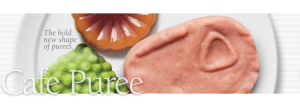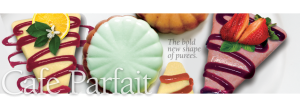Recently a Dutch company held an exposition using a 3D printer to make attractive, wholesome foods for dysphagia patients. If you are not familiar with 3D printing, the process is capable of producing a wide variety of food types, including meat and vegetables, thanks to a clever system of interchangeable print heads. “Freeze dried vegetables and fruit retain their nutritional value. By turning that into a powder and binding it with a stabilizer, they turn the foods into 3D printable paste which can be shaped and formed into attractive foods that like just like the real foods.” While the technology is still experimental it shows what the future can hold.
But why wait for the future? Our line of Café Puree meats, fruits, vegetables, pastas and breakfast items and Café Parfait desserts not only look like real food but are real food; made with healthy ingredients, not fillers, starch or gums, they are not only attractive to entice even the fussiest eaters but are a consistency that promotes a safer swallow.

Article from 3D’ers.com
Dutch hospital in Zwolle to serve 3D printed meals packed with extra nutrients to patients.
“Back in April, Dutch food 3D printing pioneers byFlow reached a very important milestone: they served a delicious five course meal produced from a 3D printer.at a pop-up restaurant during the 3D Food Printing Conference. While some critics simply called it a gimmick, byFlow already pointed out that 3D printed food pastes have numerous nutritional benefits. Not only does it make food easier to swallow, it also retains more vitamins and minerals than overcooked mushy foods and can even be packed with nutritional extras.
It sounds like a perfect solution for the elderly and for patients in hospitals, who often have trouble chewing or who are not getting enough of the fibers, vitamins or minerals that contribute to their recovery. Officials from the Isala Hospital in Zwolle, the Netherlands, have therefore set up an initiative to bring that 3D printed food to their patients together with food provider Huuskes. A wide variety of foods, including cabbages, carrots, peas, fish and even classic Dutch dishes such as kale stamppot, are already on the agenda.
While this initiative is under development, the hospital believes that 3D printing can have a huge impact on patient health and recovery. Up to 20 percent of patients in Dutch hospitals are malnourished in some way – not starving, but lacking certain vitamins that will support their recovery. After treatment, many patients can’t even stand the smell of cooked vegetables while especially cancer patients often have no appetite at all. Meanwhile, food as a medication is still everything but conventional in the medical industry.
Isala Hospital is seeking to change that, with a new policy being implemented on November 1. They will start to serve meals to patients before or after being admitted to hospitals, preferably in communal settings. Patients are more likely to eat their food while seated at a table with other patients than when propped up in a hospital bed, while the nutrients will strengthen them for any procedure that will follow. “When admitted to hospitals, especially cancer patients turn out to be malnourished. But if they eat as much as possible (and like the healthy food) well in advance, their recovery process will be much quicker,” a spokesman explained.
3D printing can play a huge role in that process, and supplier Huuskes is building on TNO studies revolving around food 3D printing. “We are still in the developmental phase with 2D printing, and were looking at options for coating foods with layers of extra nutrients. It would also be great if we can add some medication to the food itself,” the spokesman added. “Of course we will be working with fresh and natural foods, which are the healthiest. Good food in a hospital will aid recovery, and pureed and 3D printed foods shaped like mini-bonbons will certainly help.”
Isala is even planning to deliver these meals to patients at home, both before and after their stay in hospital – making them one of the first to deliver that level of care. Once that involves meals packed with additional nutrients, this will ensure that patients won’t be malnourished upon their arrival at the hospital. But it’s only the first step on a new medical path, argues food professor Jaap Seidell from the Vrije Universiteit in Amsterdam. “There’s so much you can do with good nutrition,” he says, arguing that medical faculties need to shift their paradigms and educate the next generation of doctors about the advantages of foods.”